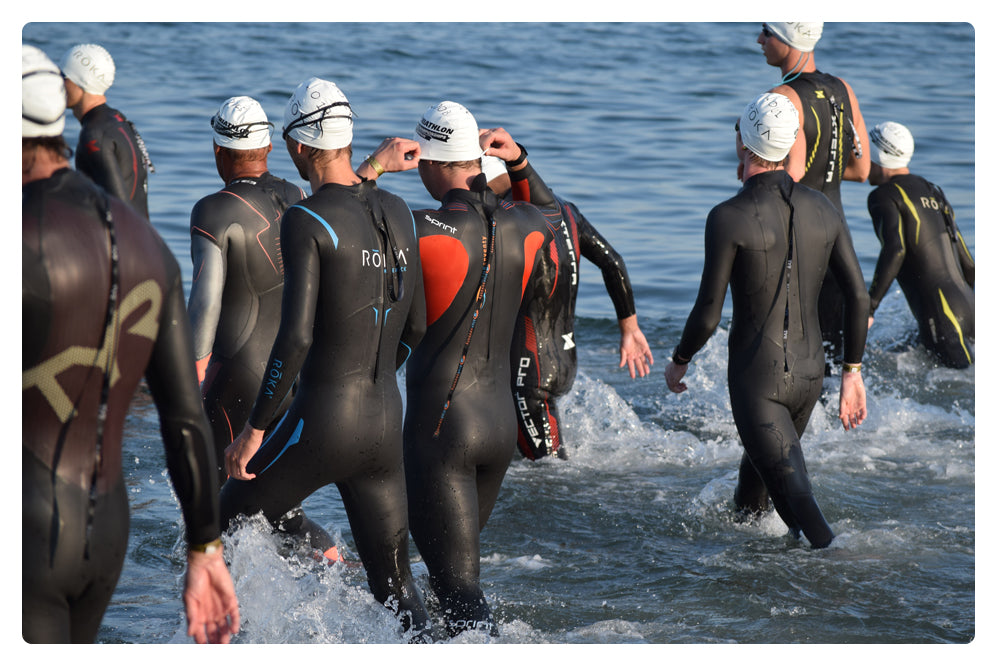
Beginner Triathlete Swim Training and Distance Chart
Many times, I will hear first-time triathletes say they are going to just “wing the swim.” At first glance, this is understandable. The swim is the shortest leg of the triathlon, but if you are not fully prepared for the swim, your race can be over, before you even get onto the bike or hit the run.
Preparing for the swim portion of a triathlon is crucial for a successful race. Here are some tips to help you get ready as well as a distance chart to show you how far you need to swim in the pool to train for your race:
POOL TRAINING DISTANCE CHART (based on a 24 yard pool)
| 1 lap | 25 yards | 1 lap | from one end of pool to the other |
| 2 laps | 50 yards | 2 laps | |
| 4 laps | 100 yards | 4 laps | |
| 1/4 mile | approx 450 yards | 18 laps | |
| 1/2 mile | approx 900 yards | 36 laps | SPRINT DISTANCE |
| 1 mile | approx 1750 yards | 70 laps | OLYMPIC DISTANCE (.9 mile) |
| 1.2 miles | approx 2100 yards | 84 laps | 70.3 IRONMAN DISTANCE |
| 1.5 miles | approx 2650 yards | 106 laps | |
| 2 miles | approx 3250 yards | 130 laps | |
| 2.4 miles | approx 4250 yards | 170 laps | IRONMAN DISTANCE |
- Build Swim Endurance:
- Gradually increase the distance you swim each session.
- Include interval training to improve speed and endurance.
- Practice Open Water Swimming:
- If possible, practice swimming in open water to simulate race conditions.
- Get comfortable with sighting, as you may need to navigate in open water. (If you have trouble with your goggles fogging, check out FOGGIES Anti-Fog Cleaning Wipes.
- Practice using TRISLIDE to get in and out of your wetsuit to save time and prevent chafing.
- Improve Technique:
- Work on your swimming technique to ensure efficiency and reduce energy expenditure.
- Consider taking lessons or getting feedback from a coach.
- Familiarize Yourself with Wetsuit:
- If the race allows wetsuits, practice swimming in yours to get used to the buoyancy and flexibility it provides.
- While swimming in wetsuits, you do not fully kick your legs. Instead, you do small flutter kicks and can even drag your legs behind.
- Train in Different Conditions:
- Train in various weather conditions to prepare for any situation on race day.
- Practice swimming in both calm and choppy water.
- Practice Transitions:
- Include swim-to-bike transitions in your training to adapt to the change in muscle engagement.
- Simulate Race Day:
- Practice entering the water quickly and efficiently to simulate the race start.
- Include some swim-bike or swim-run brick workouts.
- Work on Breathing:
- Focus on controlled and rhythmic breathing to avoid panic during the swim.
- Practice bilateral breathing to balance muscle engagement.
- Have a race song that you sing in your head while swimming. This will take your mind off the race and can help keep your swimming tempo.
- Warm-up Before the Swim:
- Warm up your body before swimming to enhance flexibility, reduce the risk of injury, and get your heart rate up.
- Ideas for warming up, jumping jacks, jogging up and down the shore, swimming.
- Get Comfortable with Crowded Conditions:
- If possible, practice swimming in a crowded pool or simulate race conditions to get used to close proximity with other swimmers.
- Build Mental Toughness:
- Work on mental strategies to stay calm and focused during the swim.
- Visualize successful swims and positive outcomes.
- Rest and Recovery:
- Ensure you get enough rest to allow your body to recover from training sessions.
- Avoid overtraining, which can lead to fatigue and decreased performance.
- Use TRISWIM Lotion with magnesium for muscle recovery.
Remember to listen to your body, stay consistent with your training, and gradually progress to build your swim fitness for the triathlon. If possible, seek guidance from a coach to tailor your training program to your specific needs. Use a chlorine-out hair and body care line if you train in a pool. Check out TRISWIM, the original Chlorine Removing Hair and Body Care Product Line.
0 comments